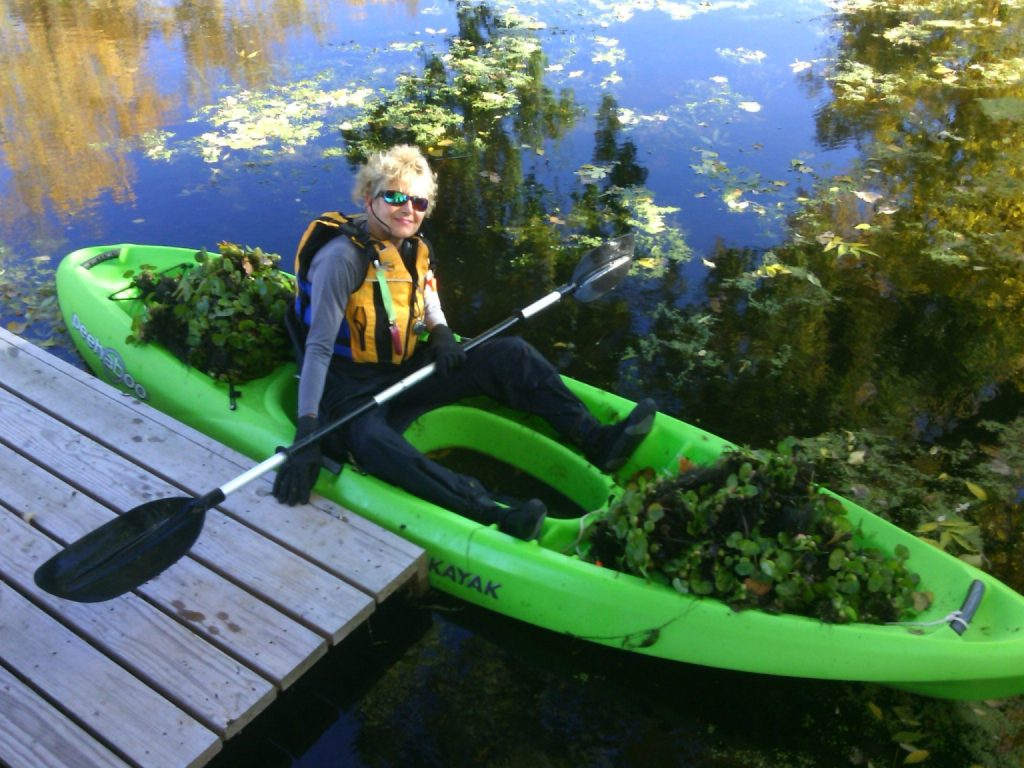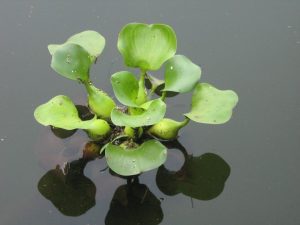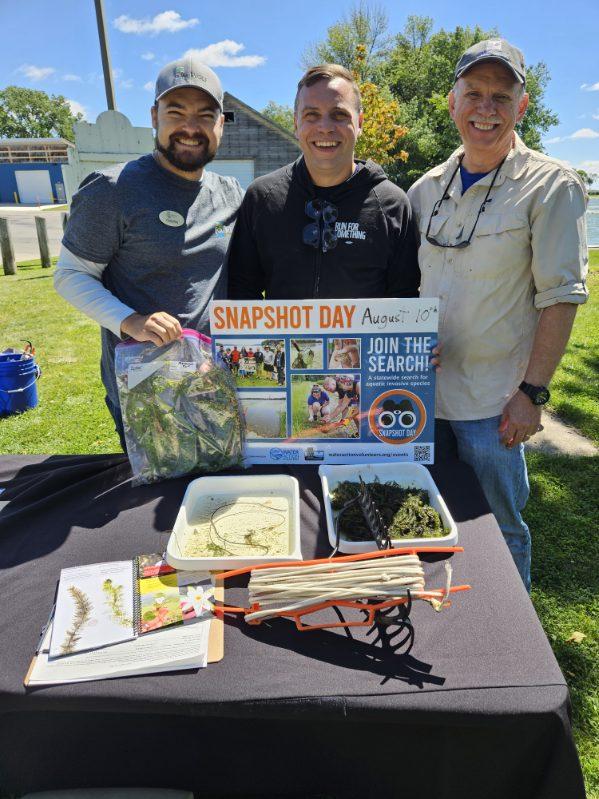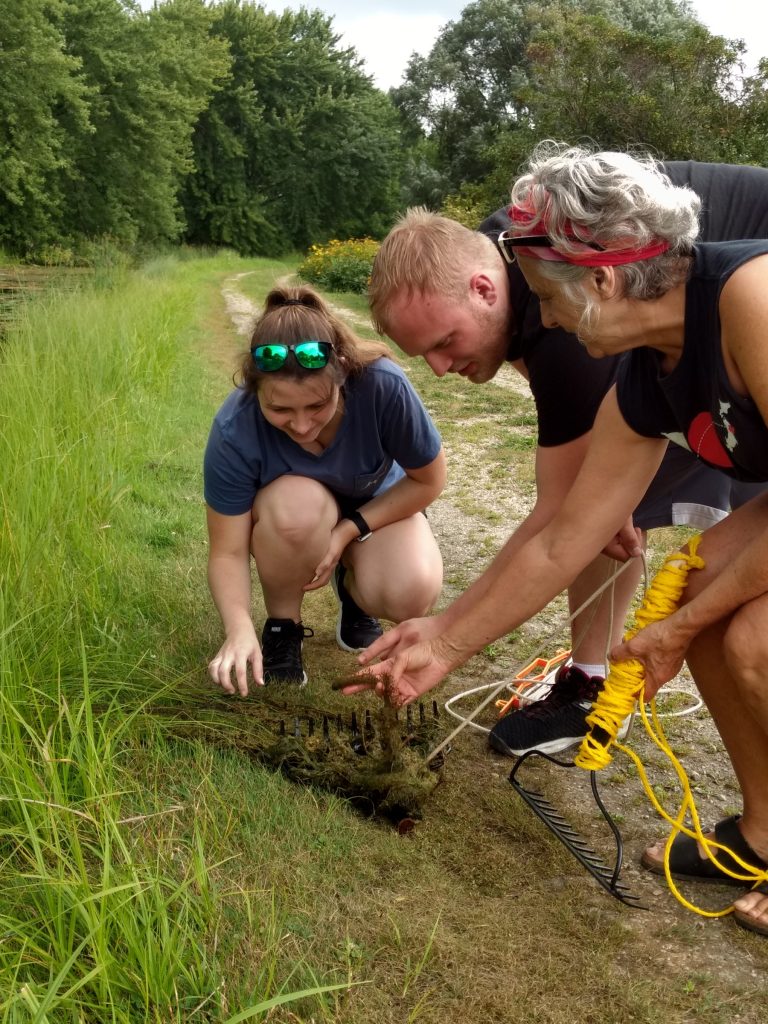
Winneconne resident Valerie Stabenow, an aquatic invasive species volunteer, has always been interested in doing things outside. A long-time UW–Madison Division of Extension Master Gardener, she once made a water garden out of an old animal stock tank and planted it full of beautiful free-floating plants — including water hyacinth. Her firsthand encounter with the fast-spreading water hyacinth became a powerful lesson when she discovered just how aggressive and damaging invasive species can sometimes be.
“When I first grew water hyacinth, I was fascinated by how fast it multiplied; one plant turned into twenty-five in just two weeks. Years later, I saw it listed as one of the invasive species on the DNR’s invasive species list. I immediately understood why,” notes Stabenow. “I spotted some growing in my local waterway near my house, still thriving after frost, and knew it was harmful. I filled a five-gallon bucket from my kayak, and there was still some remaining. Even after sealing it in black plastic bags and leaving it in the driveway for a week, it was still alive. That moment really hit me, how resilient and aggressive these plants are. As a volunteer, I don’t just look past these things. I stop, I check, and I act, because it only takes one overlooked plant to start a serious problem.”

This moment is what Chris Acy, Aquatic Invasive Species Coordinator at the Fox-Wolf Watershed Alliance, calls a lightbulb moment.
“I love seeing that lightbulb moment when I am having a conversation with someone — how perspectives change — it widens their viewpoint and changes how they are thinking about something,” says Acy. “Valerie discovering water hyacinth by her house got her interested to the point where now she is now out every summer doing the DNR protocol, looking for these invasive species. It really got her hooked.”
Every August, over a hundred community members and conservation professionals band together in search of aquatic invasive species like water hyacinth on Aquatic Invasive Species Snapshot Day. Snapshot Day is a key opportunity for folks to get introduced to aquatic invasive species monitoring and have their own lightbulb moment, according to Chris.

Snapshot Day is coordinated by Emily Heald, Rivers Educator with UW–Madison Division of Extension, in partnership with the Wisconsin Department of Natural Resources (DNR), Water Action Volunteers, and local conservation partners like the Fox-Wolf Watershed Alliance. It is a one-day event where volunteers meet at a local training site and get trained on how to identify target aquatic invasive species, and how to follow DNR search protocols. Volunteers then head out and look for invasive species at critical monitoring sites in their local community. In 2024, 36 site leaders — including Acy — brought together over 120 volunteers and collectively monitored 82 different Wisconsin water bodies. All this data is then verified and cataloged with the DNR and used to guide species control and management.
For Chris, Snapshot Day presents a new opportunity for people to get interested in aquatic invasive species and get curious about their local waterways.
“With Snapshot Day it is a great event — you get volunteers we haven’t had any interaction with before — they hear about it from Wisconsin Lakes, or UW–Madison Extension, or a friend on Facebook and are open to coming out from 9 to noon on a Saturday in August and find out about invasive species. It allows local organizations like the Fox-Wolf Watershed Alliance to broaden our network and have more eyes in the field,” notes Acy.
Importantly, Snapshot Day volunteers then know what to look for in the months or years ahead.
“Down the line, even if they can’t remember everything they learned, they remember about Snapshot Day and they are able to report back: ‘Hey, I found this weird plant in my lake — is this water hyacinth?’ They remember their local coordinator and get in touch and that helps us know where invasives are, and help limit their spread,” notes Chris.
Snapshot Day also introduces volunteers to the potential nuisance side of invasives — blocked waterways, fouled beaches, damaged fish habitat — and then equips them to stop or slow these problems before they spread from water body to water body.

Heald says the hands-on experience also provides exposure to the natural communities of plants, fish, freshwater mussels, and other invertebrates all living in harmony together.
“Once you’ve seen the balance of a healthy lake community, it’s hard to ignore when something’s off,” Heald notes. “Volunteers learn what’s at stake — and how they can protect it.”
And according to Chris and Emily, many volunteers get hooked after that first experience — similar to Valerie Stabenow. For Stabenow, protection is now a personal mission. “I want to leave my piece of Wisconsin better than I found it,” she says.




